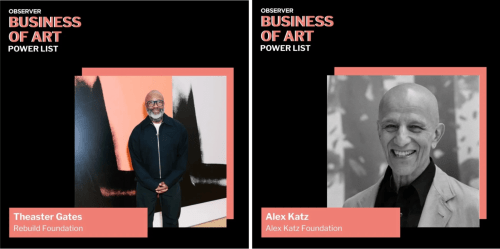
Featuring GRAY artists Alex Katz and Theaster Gates, Observer’s Business of Art Power List spotlights the bold innovators steering today’s art world through shifting markets, new collector dynamics and cultural reinvention. From market disruptors to institution builders, these visionaries are redefining influence, expanding access and setting the course for art’s global future.
Alex Katz Foundation
At 97, Alex Katz is the kind of artist who defies both age and trend, a figurative painter who’s finally getting the hero treatment he’s always claimed not to care about. Known for his large, vibrantly hued but strikingly minimalist works, Katz has been at this for over 70 years, but it’s only in the past decade or so that the art world seems to have caught up with him. This year, he pocketed a National Medal of Arts at a White House ceremony, a late-in-the-game accolade for someone who’s spent decades treating fame as an afterthought. Yet Katz is hardly the quiet type, and his works’ sheer size alone—those vast fields of color, those larger-than-life faces—give him a presence that’s impossible to ignore.
Behind the canvas, Katz plays philanthropist with a twist. His Alex Katz Foundation, founded in 2004, operates more like a gallery than a charity, buying pieces from mid-career and emerging artists only to donate them to Maine’s local institutions, such as Bowdoin College Museum of Art and Farnsworth Art Museum. Katz’s style of philanthropy has been described as “quiet,” but there’s a strategy here: he’s stacking the cultural deck, ensuring that his legacy—and the artists he has chosen to anoint—leave an imprint on museum walls. For a man whose art fills grand halls, he’s remarkably restrained when it comes to the Foundation, which he runs with his family. Of course, if Katz’s idea of “quiet philanthropy” involves donating over 700 artworks to institutions and contributing millions to arts organizations, one can only imagine what noise would look like.
His recent retrospective, “Alex Katz: Gathering,” at the Guggenheim in 2022, brought his distinct style to a broader audience—some seeing his work for the first time. And from Venice to Paris, Katz’s latest exhibitions show no signs of slowing down, as if to declare that, at nearly a century, he’s just getting started. Katz might describe himself as an accidental influencer, but his impact—both on the canvas and through his calculated donations—paints a different story: he’s left his fingerprints all over the art world, and it’s a legacy that’s built to last.
Rebuild Foundation
Theaster Gates is one of those rare art world figures who doesn’t just talk about transformation—he builds change, brick by brick. With the recent launch of the Stony Island Arts Bank Pavilion, Gates has turned Chicago’s South Side into an art sanctuary that gives Black creativity a permanent address. His new space is more than a gallery; it’s a cultural arsenal with rotating exhibitions, public programs and collaborations that carve out room for local artists in a market that often forgets them.
It’s not Gates’ style to chase art-world approval; instead, he’s brought a fresh audience to the table on his own terms, and the market has noticed. For Gates, it’s about spotlighting emerging talent in a market that tends to silo Black artists. With a significant grant for his Rebuild Foundation in 2024, Gates is doubling down on his cultural district, adding three new spaces to Chicago’s South Side (Stony Island Arts Bank, Dorchester Art + Housing Collaborative and Kenwood Gardens) that blend culture with urban renewal by transforming underused buildings into mixed-use art spaces. The artist is reshaping the art market from the ground up, proving that real change doesn’t come with a price tag—it comes with vision, a lot of grit and, in Gates’ case, community activism.
He told Observer earlier this year that “getting together is a powerful act, and it doesn’t require institutional intervention for it to happen. I am thankful for being a convener and for all the other people who have hosted amazing convenings before and after me.” Moving forward, he’s embarking on a new community-centered arts project—the development of the Philadelphia-based Forman Arts Initiative’s 100,000-square-foot campus—reinforcing his status as not just an artist but also an engaged advocate for social justice.